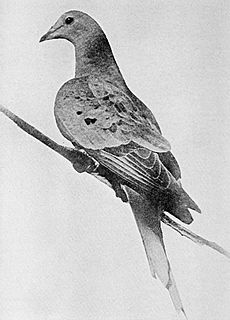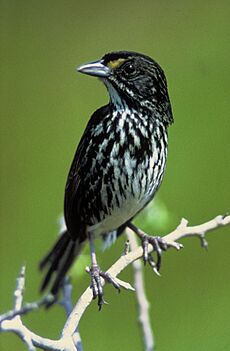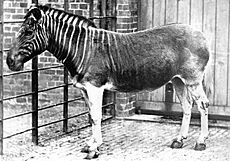Endling facts for kids
An endling is the last known individual of a species or subspecies. Once the endling dies, the species becomes extinct. The word was coined in correspondence in the scientific journal Nature.
Usage
The 4 April 1996 issue of Nature published a correspondence in which commentators suggested that a new word, endling, be adopted to denote the last individual of a species. The 23 May issue of Nature published several counter-suggestions, including ender, terminarch, and relict.
The word endling appeared on the walls of the National Museum of Australia in Tangled Destinies, a 2001 exhibition by Matt Kirchman and Scott Guerin, about the relationship between Australian peoples and their land. In the exhibition, the definition, as it appeared in Nature, was printed in large letters on the wall above two specimens of the extinct Tasmanian tiger: "Endling (n.) The last surviving individual of a species of animal or plant". A printed description of this exhibition offered a similar definition, omitting reference to plants: "An endling is the name given to an animal that is the last of its species."
In The Flight of the Emu: A Hundred Years of Australian Ornithology 1901-2001, author Libby Robin stated that "the very last individual of a species" is "what scientists refer to as an 'endling'".
In 2011, the word was used in the Earth Island Journal, in an essay by Eric Freedman entitled "Extinction Is Forever: A Quest for the Last Known Survivors". Freedman defined endling as "the last known specimen of her species."
In "The Sense of an Endling", author Helen Lewis describes the notion of an endling as poignant, and the word as "wonderfully Tolkien-esque".
Author Eric Freedman describes endling as "a word with finality", stating, "It is deep-to-the-bone chilling to know the exact date a species disappeared from Earth. It is even more ghastly to look upon the place where it happened and know that nobody knew or cared at the time what had transpired and why."
Notable endlings

This is not a comprehensive list of contemporary extinction, but a list of high-profile, widely publicised examples of when the last individual of a species was known.
Birds
- The passenger pigeon (Ectopistes migratorius) became extinct at 1 p.m. on 1 September 1914 with the death of Martha, the last surviving member of the species, at the Cincinnati Zoo.
- Incas, the last known Carolina parakeet (Conuropsis carolinensis), died, also at the Cincinnati Zoo, on 21 February 1918. The species was officially declared extinct in 1939.
- Booming Ben, a solitary heath hen (Tympanuchus cupido cupido), was last seen 11 March 1932 on Martha's Vineyard, Massachusetts.
- Orange Band was the last known dusky seaside sparrow (Ammodramus maritumus nigrescens), who died on 17 June 1987 at the Discovery Island zoological park at Walt Disney World Resort.
Mammals
- In 1627, the last aurochs (Bos primigenius), an ancestor of bovine and cattle, died in a forest near what is now Jaktorów in modern-day Poland.
- The quagga (Equus quagga quagga) became extinct in the wild in the late 1870s due to hunting for meat and skins, and the subspecies' endling died in captivity on 12 August 1883 at the Artis in Amsterdam.
- On 7 September 1936, the last known captive thylacine (Thylacinus cynocephalus), also called Tasmanian tiger, died in Hobart Zoo, following persecution of the species through hunting and trapping. Information published about this individual has been conflicted throughout the decades following its death. Areas of contention include whether it was male or female, whether it was named "Benjamin" or not, where it was captured, by whom it was captured, whether it was neglected in its zoo enclosure and even whether it was the last known surviving Thylacine. A comprehensive analysis of the history of this individual published in 2023 concludes or re-affirms that it was male, captured on 7 July 1930, at Penney's Flats in northwestern Tasmania by Roy and Dan Delphin, never called Benjamin during its lifetime and that it was the most valued animal in the zoo's collection, not neglected and that it died of old age. Although it is generally accepted the Thylacine probably persisted in the wild following the death of this individual, the Tasmanian Tiger at Hobart Zoo is considered the endling not only for its species, but also the family Thylacinidae.
- Celia, the last Pyrenean ibex (Capra pyrenaica pyrenaica), was found dead on 6 January 2000 in the Spanish Pyrenees, after hunting and competition from livestock reduced the population to one individual.
Reptiles and amphibians
- On 24 June 2012, Lonesome George, the last known Pinta Island tortoise (Chelonoidis niger abingdonii), died in his habitat in the Galápagos Islands.
- Until September 26, 2016, the Atlanta Botanical Garden was home to the last known surviving Rabbs' fringe-limbed treefrog (Ecnomiohyla rabborum) named "Toughie".
- After being considered possibly extinct for 113 years, a Fernandina Island Galápagos tortoise was found in 2019. However, this female is the only confirmed individual.
Invertebrates
- Turgi was the last Partula turgida, a Polynesian tree snail, who died on 31 January 1996 in the London Zoo.
- A tank in the Bristol Zoo was the last refuge of Partula faba, a land snail from Ra'iātea in French Polynesia. The population dropped from 38 in 2012 to one in 2015. The last individual died on 21 February 2016.
- George was the last known individual of the Oahu tree snail species Achatinella apexfulva. He died on January 1, 2019, in captivity near Kailua, Hawaii.
Plants
- The Curepipe Botanic Gardens in Mauritius have housed the last specimen of the palm Hyophorbe amaricaulis since the 1950s.
- Pennantia baylisiana has only ever been known from one wild tree that still lives today. Subsequent trees were cloned, but since 1985 hundreds of trees have been propagated by self-pollination.
- Only one individual of the Wood's cycad (Encephalartos woodii) has existed since it was discovered in 1895, all examples being clones of this single male individual.
- Only one living specimen of the tree species Madhuca diplostemon is known to exist.
See also
- Anthropocene
- Conservation status
- De-extinction
- Extinction
- Frozen zoo (some store genetic material from endlings)
- Holocene extinction
- Lists of extinct animals
- List of neologisms
- Rare species
- Terminal speaker






